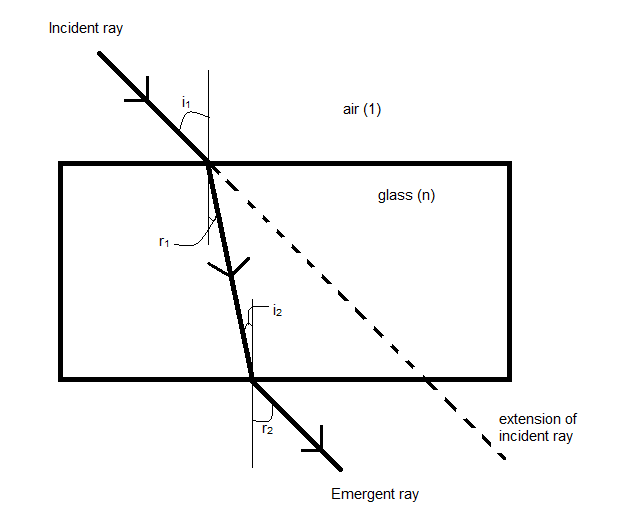
“During refraction of light through the glass slab, incident ray and emergent ray are parallel to each other.” Explain.
Answer
511.5k+ views
Hint: This problem can be solved by using Snell’s law at both edges (the edge at which the incident ray enters the slab and the edge at which the emergent ray leaves the slab) of a glass slab. Therefore, we can find out a relation between the respective angles of incidence and angles of refraction at both edges which will help us to explain the question statement.
Formula used:
When light travels from a medium of optical density
Complete step by step answer:
Let us start off by drawing a diagram.

Here, we have a light ray entering into a glass slab of refractive index
The emergent ray leaves the glass slab from the other edge with the angle of refraction
The incident ray has been extended virtually to show its path in the absence of the glass slab.
When light travels from a medium of optical density
The angle of refraction at the incident edge is
Now, applying (1) at the incident edge, we get,
Now, the light ray in the glass slab acts as a transversal between two parallel vertical lines.
Hence,
Now, applying (1), at the emergent edge, we get,
Hence, the incident ray and the emergent ray make the same angle with the vertical. Hence, since lines which make the same angle with another line are parallel, therefore, the incident ray and emergent ray are parallel.
Therefore, during refraction of light through the glass slab, incident ray and emergent ray are parallel to each other.
Note: In optics, the main approach to solving a problem should be to draw a proper diagram. By drawing a proper diagram, relations can be found out between different variables in the problem by using geometry, construction or trigonometry. The diagram also makes the question very easy to visualize, since our brain is better able to remember and understand a picture.
Though the incident and emergent ray are parallel to each other, the emergent ray has been laterally shifted. This happens while light goes through a glass slab. This is known as the lateral displacement. This is the reason why the letters of a newspaper seem to get shifted when a glass slab is kept over it.
Formula used:
When light travels from a medium of optical density
Complete step by step answer:
Let us start off by drawing a diagram.

Here, we have a light ray entering into a glass slab of refractive index
The emergent ray leaves the glass slab from the other edge with the angle of refraction
The incident ray has been extended virtually to show its path in the absence of the glass slab.
When light travels from a medium of optical density
The angle of refraction at the incident edge is
Now, applying (1) at the incident edge, we get,
Now, the light ray in the glass slab acts as a transversal between two parallel vertical lines.
Hence,
Now, applying (1), at the emergent edge, we get,
Hence, the incident ray and the emergent ray make the same angle with the vertical. Hence, since lines which make the same angle with another line are parallel, therefore, the incident ray and emergent ray are parallel.
Therefore, during refraction of light through the glass slab, incident ray and emergent ray are parallel to each other.
Note: In optics, the main approach to solving a problem should be to draw a proper diagram. By drawing a proper diagram, relations can be found out between different variables in the problem by using geometry, construction or trigonometry. The diagram also makes the question very easy to visualize, since our brain is better able to remember and understand a picture.
Though the incident and emergent ray are parallel to each other, the emergent ray has been laterally shifted. This happens while light goes through a glass slab. This is known as the lateral displacement. This is the reason why the letters of a newspaper seem to get shifted when a glass slab is kept over it.
Latest Vedantu courses for you
Grade 10 | CBSE | SCHOOL | English
Vedantu 10 CBSE Pro Course - (2025-26)
School Full course for CBSE students
₹37,300 per year
Recently Updated Pages
Master Class 9 General Knowledge: Engaging Questions & Answers for Success

Master Class 9 English: Engaging Questions & Answers for Success

Master Class 9 Science: Engaging Questions & Answers for Success

Master Class 9 Social Science: Engaging Questions & Answers for Success

Master Class 9 Maths: Engaging Questions & Answers for Success

Class 9 Question and Answer - Your Ultimate Solutions Guide

Trending doubts
Give 10 examples of unisexual and bisexual flowers

Draw a labelled sketch of the human eye class 12 physics CBSE

Differentiate between homogeneous and heterogeneous class 12 chemistry CBSE

Differentiate between insitu conservation and exsitu class 12 biology CBSE

What are the major means of transport Explain each class 12 social science CBSE

Draw a diagram of a flower and name the parts class 12 biology ICSE




